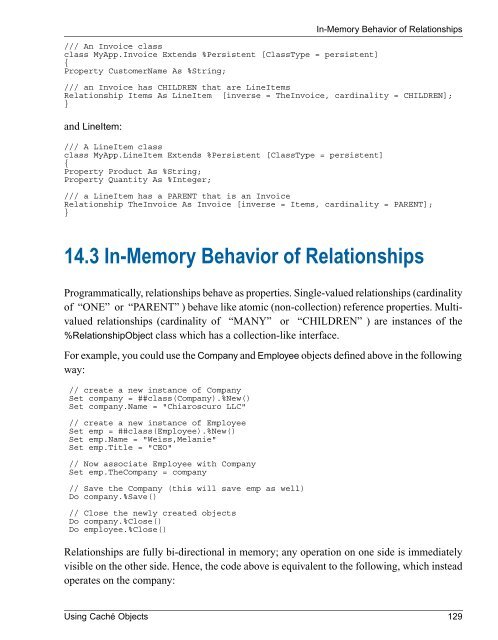Using Caché Objects - InterSystems Documentation
Using Caché Objects - InterSystems Documentation
Using Caché Objects - InterSystems Documentation
You also want an ePaper? Increase the reach of your titles
YUMPU automatically turns print PDFs into web optimized ePapers that Google loves.
An Invoice class<br />
class MyApp.Invoice Extends %Persistent [ClassType = persistent]<br />
{<br />
Property CustomerName As %String;<br />
/// an Invoice has CHILDREN that are LineItems<br />
Relationship Items As LineItem [inverse = TheInvoice, cardinality = CHILDREN];<br />
}<br />
and LineItem:<br />
/// A LineItem class<br />
class MyApp.LineItem Extends %Persistent [ClassType = persistent]<br />
{<br />
Property Product As %String;<br />
Property Quantity As %Integer;<br />
In-Memory Behavior of Relationships<br />
/// a LineItem has a PARENT that is an Invoice<br />
Relationship TheInvoice As Invoice [inverse = Items, cardinality = PARENT];<br />
}<br />
14.3 In-Memory Behavior of Relationships<br />
Programmatically, relationships behave as properties. Single-valued relationships (cardinality<br />
of “ONE” or “PARENT” ) behave like atomic (non-collection) reference properties. Multivalued<br />
relationships (cardinality of “MANY” or “CHILDREN” ) are instances of the<br />
%RelationshipObject class which has a collection-like interface.<br />
For example, you could use the Company and Employee objects defined above in the following<br />
way:<br />
// create a new instance of Company<br />
Set company = ##class(Company).%New()<br />
Set company.Name = "Chiaroscuro LLC"<br />
// create a new instance of Employee<br />
Set emp = ##class(Employee).%New()<br />
Set emp.Name = "Weiss,Melanie"<br />
Set emp.Title = "CEO"<br />
// Now associate Employee with Company<br />
Set emp.TheCompany = company<br />
// Save the Company (this will save emp as well)<br />
Do company.%Save()<br />
// Close the newly created objects<br />
Do company.%Close()<br />
Do employee.%Close()<br />
Relationships are fully bi-directional in memory; any operation on one side is immediately<br />
visible on the other side. Hence, the code above is equivalent to the following, which instead<br />
operates on the company:<br />
<strong>Using</strong> <strong>Caché</strong> <strong>Objects</strong> 129

















